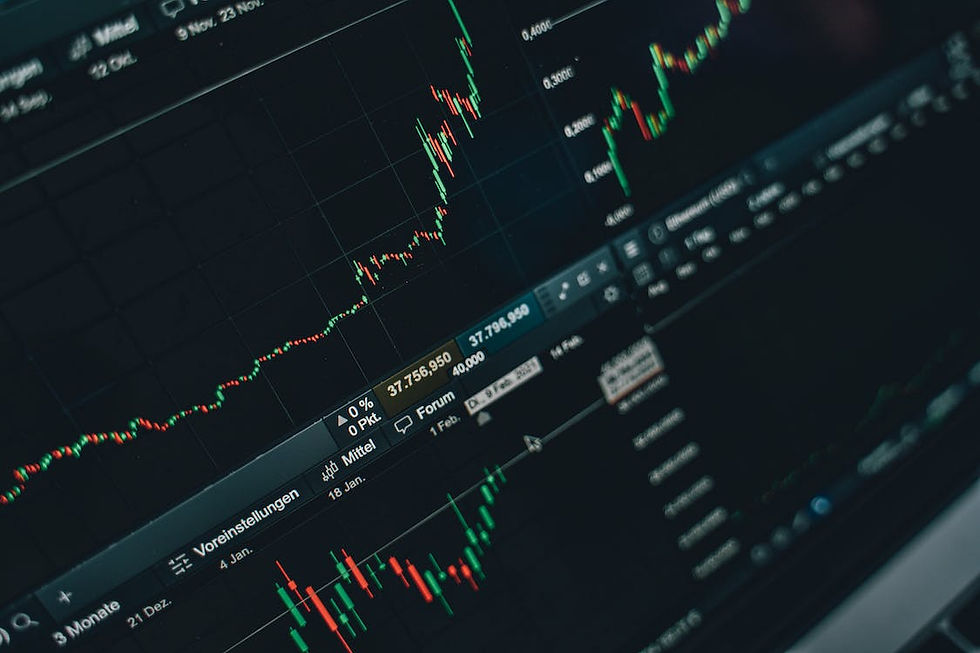"Impact of Inflation on Investments: Strategies for Preserving Purchasing Power":
- The Moolah Team
- Jul 11, 2023
- 6 min read
This post will explore the impact of inflation on investments and provide strategies for investors to protect their portfolios against inflation and preserve their purchasing power.
I. Introduction
I.1 Inflation and Its Impact on Investments
Inflation is a significant economic factor that affects people's lives in many ways. It refers to the general increase in prices of goods and services over time, which can lead to a decrease in the purchasing power of money. As a result, inflation can have a substantial impact on investments, making it difficult to achieve long-term financial goals.
The value of investments is not only influenced by inflation, but also by many other factors such as market conditions, interest rates, and geopolitical events. However, inflation is an essential factor that investors need to consider because it can erode the value of their investments over time.
I.2 The Importance of Understanding Inflation
It is important to understand inflation and its effects on investments to make informed financial decisions. Inflation can lead to a decrease in the value of money and a rise in the cost of goods and services, making it more challenging to save for the future and achieve financial goals.
Moreover, inflation is a dynamic factor that changes over time, making it difficult to predict its impact on investments accurately. Therefore, investors need to understand inflation trends and their effects on different types of investments to make informed decisions and protect their portfolios from the eroding effects of inflation.
I.3 The Purpose of the Blog Post
The purpose of this blog post is to provide an in-depth analysis of the impact of inflation on investments and offer strategies for investors to preserve their purchasing power.
The blog post will discuss the following topics:
Understanding Inflation and Its Effects on Investments
Strategies for Protecting Investments Against Inflation
Other Considerations for Preserving Purchasing Power
Implementing Inflation Protection Strategies
By the end of this blog post, readers will have a comprehensive understanding of inflation and its effects on investments, as well as strategies for preserving their purchasing power.

II. Strategies for Protecting Investments Against Inflation
Investors can protect their portfolios from the eroding effects of inflation by using various strategies. These strategies aim to preserve the purchasing power of the portfolio, maintain a balance between risk and return, and provide long-term growth potential. Below are some of the strategies investors can use to protect their investments against inflation.
II.1 Investing in Inflation-Protected Securities
One of the most popular strategies for protecting investments against inflation is investing in inflation-protected securities, such as Treasury Inflation-Protected Securities (TIPS). TIPS are bonds issued by the U.S. government that offer a fixed interest rate but adjust their principal value based on changes in the Consumer Price Index (CPI), which measures inflation.
TIPS provide a guaranteed real return, meaning that investors earn a return that is adjusted for inflation. This feature makes TIPS an attractive investment option for investors who want to protect their purchasing power and earn a real return. However, TIPS are not risk-free, and their returns can be affected by changes in interest rates and other market conditions.
II.2 Diversifying Your Portfolio with Tangible Assets
Another strategy for protecting investments against inflation is diversifying the portfolio with tangible assets, such as real estate, gold, and commodities. Tangible assets have an intrinsic value that is not affected by inflation, making them a useful hedge against inflation.
Investors can use various instruments to invest in tangible assets, such as exchange-traded funds (ETFs), mutual funds, and real estate investment trusts (REITs). These instruments provide a diversified exposure to tangible assets and offer a convenient way to invest in different markets.
II.3 Investing in Stocks with Pricing Power
Investing in stocks with pricing power is another strategy that can help investors protect their portfolios against inflation. Companies with pricing power can increase the prices of their products or services without losing their market share, providing a hedge against inflation.
Stocks with pricing power are usually found in industries with high barriers to entry, such as healthcare, utilities, and consumer staples. These companies have established brand names, large customer bases, and significant market share, making it difficult for new competitors to enter the market and drive down prices.
II.4 Utilizing Real Estate Investments
Real estate investments can also be a useful strategy for protecting investments against inflation. Real estate investments provide a hedge against inflation because the value of the property and the rent charged for it can increase over time, providing a real return to investors.
Investors can invest in real estate directly by buying property or indirectly through real estate investment trusts (REITs). REITs offer a convenient way to invest in different types of real estate assets, such as residential, commercial, and industrial properties.
II.5 Investing in Commodities
Finally, investors can also protect their portfolios against inflation by investing in commodities, such as oil, natural gas, and precious metals. Commodities are tangible assets that have intrinsic value, making them a useful hedge against inflation.
Investors can invest in commodities directly by buying physical commodities or indirectly through exchange-traded funds (ETFs) or mutual funds that invest in commodities. These instruments offer a convenient way to invest in different types of commodities and provide diversification benefits.
In conclusion, protecting investments against inflation is essential to preserve the purchasing power of the portfolio and achieve long-term financial goals. Investors can use various strategies to protect their portfolios, such as investing in inflation-protected securities, diversifying the portfolio with tangible assets, investing in stocks with pricing power, utilizing real estate investments, and investing in commodities.

III. Strategies for Preserving Purchasing Power
As we have seen, inflation can erode the purchasing power of your investments over time, and it's important to take steps to mitigate its impact.
Here are some strategies you can consider for preserving your purchasing power:
A. Invest in Real Assets:
One way to protect against inflation is to invest in real assets such as real estate, commodities, and infrastructure. These assets tend to appreciate in value over time as inflation increases the cost of goods and services. Real estate, in particular, can be a good hedge against inflation as rents and property values tend to rise with inflation.
B. Invest in TIPS:
Treasury Inflation-Protected Securities (TIPS) are bonds issued by the U.S. government that are designed to protect against inflation. TIPS pay a fixed interest rate, but the principal is adjusted for inflation based on the Consumer Price Index (CPI). This means that as inflation rises, so does the value of your investment.
C. Consider Dividend-Paying Stocks:
Stocks that pay dividends can also be a good option for inflation protection. Dividends tend to increase over time, which can help offset the impact of inflation. Additionally, companies that pay dividends tend to be more established and financially stable, which can provide some level of safety for your investment.
D. Diversify Your Portfolio:
Diversification is key to any successful investment strategy, and it can also help protect against inflation. By spreading your investments across different asset classes, you can reduce your exposure to any one particular asset that may be negatively impacted by inflation.
E. Use Inflation-Linked Bonds:
Inflation-linked bonds are a type of bond where the principal and interest payments are adjusted for inflation. These bonds are issued by governments and corporations and can be a good option for investors looking to protect against inflation.
F. Avoid Long-Term Fixed-Rate Bonds:
Long-term fixed-rate bonds can be risky in an inflationary environment as the fixed interest rate may not keep up with inflation. If you hold these bonds to maturity, you may end up with a nominal return that is lower than the rate of inflation.
G. Consider Alternative Investments:
Alternative investments such as private equity, hedge funds, and real estate investment trusts (REITs) can also provide some level of protection against inflation. These investments are often less correlated with traditional stocks and bonds and may perform well in an inflationary environment.
By implementing one or more of these strategies, you can help protect your investments against inflation and preserve your purchasing power over time. However, it's important to remember that no investment strategy is fool proof, and there are always risks to consider. Be sure to consult with a financial advisor before making any investment decisions.

IV. Conclusion
Inflation is an important factor to consider when investing, as it can erode the purchasing power of your investments over time. However, there are strategies you can use to protect against inflation and preserve your purchasing power.
First, it's important to understand the impact of inflation on your investments and take steps to mitigate its impact. This can include investing in real assets, using inflation-linked bonds, diversifying your portfolio, and avoiding long-term fixed-rate bonds.
It's also important to keep in mind that no investment strategy is fool proof and there are always risks to consider. Be sure to consult with a financial advisor before making any investment decisions.
In summary, inflation is a risk that all investors face, but with the right strategies, you can protect your investments and preserve your purchasing power over time. By staying informed and taking action to mitigate the impact of inflation, you can achieve your investment goals and secure your financial future.
Thanks for reading our post on the impact of inflation on investments and strategies for preserving purchasing power. We hope you found it informative and helpful in your investment journey. Don't forget to subscribe to our newsletter for more valuable insights and updates. Thanks a million for your time and support!
From Moolah







Comments